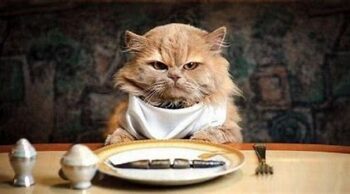Do you have the challenge of trying to feed a finicky cat? Normally, my Mocha does not have this problem. He does like a change of diet fairly regularly, but usually he eats his meal with good appetite. However, lately he has become a problem eater, so I decided this topic might serve a good one to investigate, both for myself and for others with a similar challenge.
A cat who lives in the wild and does his own hunting will prove very open to trying new foods. He needs to eat, so if the food seems edible, he will try it. Thus, he has interest in a wide range of foods. If your cat suddenly becomes finicky, something prevents this natural feeding behavior. It is important for you to figure out why he does not eat readily.

Could The Cat Have A Health Problem?
Health reasons could explain why he has become so finicky. Dental problems, an injured jaw, gastrointestinal issues, or other underlying health conditions can contribute. If you can see no immediate reasons for the behavior change, it’s important to consult your vet to rule out such concerns.
If the cat gets a good health report, then it becomes your task to determine the underlying cause of the change in appetite or unwillingness to eat a food he normally likes. If the problem is ongoing, perhaps it can have to do with his earliest experiences with meals.
Find Out Kitty’s Taste Preferences
Cats are “imprint eaters,” meaning they develop life-long taste preferences shaped by their early eating habits. If you try a new food, perhaps it falls outside this range of preferences. For example, strange though it seems, my cat does not care for tuna or fresh fish, unless it’s salmon. Try to give him any other flavor of fish and he turns up his nose.
A negative experience with a certain food in kitty’s early history can influence a taste preference. Also, you might find an environmental difference. A domestic house cat may not care for raw meat, while a free-roaming farm cat might avoid dry food.
A cat should not go for a long period without eating. If your cat seems healthy, he probably does not like the food, or has some other reason, perhaps related to stress. If the cat seems lethargic or sick, see the vet.
The Feeding Bowl Has Importance
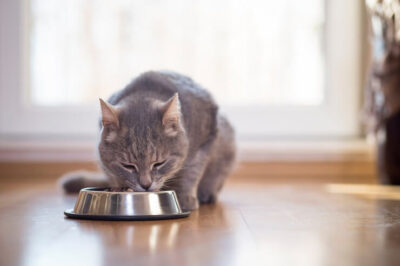
Cats should have their own bowl for meals, preferably out of sight of any other animal. Avoid placing the bowl where loud noises, for example, from a washing machine, may stop him from eating. Avoid placing the bowl where the cat may become afraid to eat for some reason.
Be sure to select good-quality food that has all the nutrients that kitty needs. Taste and palatability are important factors to look for in a commercial food. Aroma, temperature, nutritional value, freshness, variety of tastes and shapes all have importance. The best temperature for a cat’s food is around 86 degrees. Also, smell can stimulate kitty’s appetite, but if the food is spoiled, he will know that also, and won’t eat it.
The Best Feeding Strategies for Picky Eaters
Stress can be a big cause of feeding problems. Any deviation from kitty’s normal meal-time routine can upset him. Such changes can make him highly suspicious of his food and cause avoidance. Routine changes make him anxious and picky.
Stress can originate from other causes, such as excessive noise, new family members, vet trips, or changes to his environment. I discovered that stress served as the basis for my cat’s sudden picky eating behavior. I just gained a new housemate, and to make matters worse, she has a small dog.
Fortunately for the cat, the dog is completely non-aggressive. She is aging and spends most of her day sleeping. Nonetheless, because of the dog’s presence, I had to change kitty’s regular eating spot. Also, he won’t eat his wet food unless I shut the door to the outer rooms and sit with him.
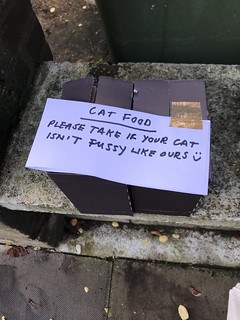
I feel it’s important he have wet food, so he gets it first. Then he gets his serving of dry food. Strange — he eats the kibble with no problem. I’ve had to try a couple of techniques with the wet food. One article I read suggests crushing some kibble and putting it on top of the wet food. I tried it. Mocha just licked all the crushed food off the top and would not eat the canned food.
This Method Works Best For Us
The technique that works best for us is to embed a few pieces of kibble into the wet food. Then he will eat that piece and some of the food around it as well. Sometimes he forgets himself and eats an extra portion of the canned stuff as well.
Try various toppers on the food. One article I read suggests “Marie’s Magical Dinner Dust.” It’s freeze-dried, raw, and nutritious with a convenient pour spot. Another suggestion: try a broth topper, such as a pet-safe low sodium chicken broth. Perhaps a sprinkling of catnip will help.
Setting The Stage For Maximum Success
Use the right kind of food bowl. It should always be clean. It needs to be shallow and wide enough so kitty’s whiskers will fit in it without touching the sides. Use glass, ceramic, or stainless steel, not plastic. A plastic bowl can trap bacteria and odor. You might try elevating the bowl.
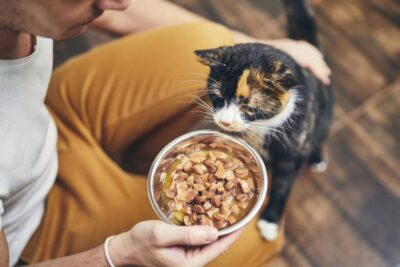
Provide a calm, predictable environment. Your feeding schedule should be consistent, so kitty know when meals can be expected. Try giving the food and walking away. However, some cats, such as my Mocha, now that he’s stressed about meals, prefers me to stay with him. Once he gets to the dry kibble, I can walk away.
Sometimes a cat likes to be petted while he’s eating. It must remind kitty of Mama Cat. Watch his body language to help determine what he likes. When trying to get the best food inside the cat, minimize the number of treats and give them at specific times. He may try to hold out for treats, and this behavior defeats your purpose.
A Cat Can Become Bored With The Same Foods
Rotate food flavors. Kitty may get bored with the same food every day, so a regular change may be helpful. If you are trying a new food, you might place a portion next to the old food until he gets used to the change.

If your cat eats all the food, make it your habit to praise him. Kitty needs to know when he has done something that pleases you. If a food has just lingered in the bowl for quite some time, remove it. I do find, however, that if I give Mocha a food at the evening meal and he only eats part of it, he will often come back and finish sometime during the night.
Make sure the surroundings where you place the food do not disturb the cat but provide a peaceful setting. Be sure to introduce new foods gradually to ascertain that they do not upset his digestive system.
Do remember that each cat has its own unique personality and preferences. Do your best to learn these if you wish for mealtime success.
Nutritional Considerations for a Balanced Feline Diet
Cats are obligate carnivores, which means their bodies are designed to digest and use only animal-based proteins effectively. A balanced diet for a cat is crucial for its overall health and well-being.
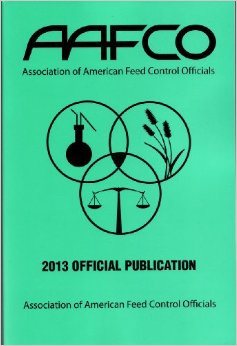
Essential nutrients that every cat diet should include are proteins, fats, amino acids like taurine and arginine, vitamins, minerals, and certain fatty acids. While carbohydrates are not inherently harmful, cats have little nutritional requirement for them.
When selecting a commercial cat food, inspect the ingredient list for high-quality protein sources, such as real meat, poultry, or fish. Fillers and by-products should be minimal to ensure the food’s nutritional integrity.
Homemade diets can offer freshness and simplicity, but they must be carefully researched and formulated to avoid nutritional deficiencies. Consulting with a veterinarian or a veterinary nutritionist is vital before choosing this route.
Your vet’s advice can be invaluable when choosing the right food for a finicky eater. They can recommend specific brands, dietary supplements, or prescription diets that address both the pickiness and the nutritional needs of your cat.
Turning Mealtime into a Rewarding Experience
If you can turn mealtime into an experience that rewards your cat, you have made a great step forward.
One effective method is to incorporate play into feeding. Cats are natural hunters, and playing before eating can mimic the rewarding experience of catching prey. Using interactive feeding toys or puzzle feeders that require your cat to work for their food can also stimulate their interest in eating.
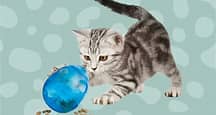
Mocha has a puzzle feeder that I use at times for dry kibble. Not only does this eating game simulate a real hunt, but it also slows down the speed in which the cat devours the food, thus aiding digestion.
Creating a consistent mealtime ritual can also be beneficial. Cats thrive on routine, and establishing set feeding times can help your cat feel more secure, thus more likely to eat. This means feeding your cat at the same times every day and in a quiet, safe space where they can eat undisturbed.
Include Lots Of Positive Reinforcement
Positive reinforcement is key. Praise your cat for eating, even if they only take a few bites. A soft voice and gentle encouragement can boost their confidence and association with mealtime as a positive experience.
Remember, persistence is crucial. If you don’t see immediate changes, don’t be discouraged. Cats are creatures of habit, so any new feeding tactic will require some patience. But if after consistent effort your cat still isn’t showing interest in eating, or if their eating habits change suddenly, consult with a veterinarian. There could be underlying health issues that need addressing.
As you strive to create an enriching and stress-free mealtime environment, you’re not just focusing on the physical nourishment of your feline friend, but also on their overall well-being. A happy cat is often a healthy one, and the positive changes in their eating habits might just surprise you.
References I used for this post: www.webmd.com/pets/cats/features/how-to-deal-with-a-cat-thats-a-picky-eater http://cats.com/how-to-get-a-picky-cat-to-eat/ www.stellaandchewys.com/cats/13-tips-for-cat-picky-eaters/

